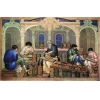|
 Khokhloma is
a settlement in Russia,
district of the Nizhniy Novgorod. Handicraft from various places was sold there
brought from the neighboring villages, including the wooden tableware painted
with fascinating patterns. The tableware was bought in the village and spread
throughout Russia
and to other places. The consumers never sort out the way the tableware was
manufactured and who made it and very soon the painting was named after the
settlement it was marketed. Khokhloma is
a settlement in Russia,
district of the Nizhniy Novgorod. Handicraft from various places was sold there
brought from the neighboring villages, including the wooden tableware painted
with fascinating patterns. The tableware was bought in the village and spread
throughout Russia
and to other places. The consumers never sort out the way the tableware was
manufactured and who made it and very soon the painting was named after the
settlement it was marketed.
Khokhloma is
the decorative painting of tableware and furniture. The painting is made in
black, red and sometimes in green paints on the golden background. The choice of
color used for painting comes from the ancient legend. They say that once upon
a time a painter lived in old Russia
who was a court worker. He dreamed about creating something unusual that threw
back in the core of the native land which is familiar to every person. And trying
to make his dream come true, the painter escaped from the desired life at the
court of the Russian king and settled in the forest. He built the house of logs,
made wooden tableware and started painting it in the way he liked. His
followers came to work by the painter and a rich settlement grew in the forest.
As for colors,
the point is that the establishment of the settlement is not the end of the
story. The king caused to make the painter back to the court, yet, he was
revolted with the ingratitude of the painter! The master shared the secrets of his
skills with his fellow villagers when he was warned that a troop was sent to
take him back to the king. The guards saw just the log house in the red fire on
the black dead ground and some greenery around. The painter disappeared. Though,
the gold of the flame, the black of the ground and green of the grass was then
realized in Khohloma items.
The Khokhloma painting is different from others since it is made on the wood but the wood is
not seen, as if the metal articles are painted. This effect is achieved by a small
very smart technological approach.
The
painters from Khokhloma were willing to have the rich and noble tableware the
royal family used in palaces. The royal tableware was decorated with the gold
leaves (thin golden sheets to attach to items) or silver gold (the gold diluted
with the special powder which is applied to the articles as the plain paint).
Gold is gold and it costs a fortune. The icon-painter used to cover the silver sheets
with the drying oil with the purpose to have the gilding reduced in cost which
brings the effect of gold finally. The peasant masters of the painting improved
their skills and practiced using drying oil instead of silver.
The gilding
was not applied to the whole article and only some particular elements were
gilded, and the pattern was very simple. When the glazed pottery and metal
tableware affordable to the public appeared in the market, the Kokhloma
craftsmen improved the painting to survive among the competitors. They
practiced gilding the entire article and the herbal patterns were first introduced.
As a result, the Khokhloma painting did not survive the competition; it became
more demanded and popular in the world. To the end of XIX century the painting
exhibited at world shows, and it was the real feat of the Khokhloma style at the
world exhibition in Paris
in 1889.
Nowadays,
the technology of the Khohloma painting has not undergone sea changes, Aluminum
is used currently instead of the tin which is cheaper and affordable, and the tableware
is dried in electric furnaces. This is the difference when in total the technique is thesame as earlier.
The key
secret of the beauty of the painting is not the technology. The artistic skills
of painters work here. The floral and animal patterns and the legendary herbal
ornaments appear to be the major attractive element of the painting. Every item
is unique and fascinating. All the items are hand-made, and the patterns are
not replicated. The Khohloma painting is what refers to genius Russia. This is
what we call the old ancient traditions and customs. The Khokhloma painting is
the frozen Russian beauty as well as music, though alive and magnificent for
ever.
|